The use of X-ray-based nondestructive test methods dates back more than a hundred years, with the advent of film-based radiography. Today, radiographic inspection is employed to examine variations in structures, track minute changes in surface finish, determine a material’s thickness, or detect physical defects or other characteristics of a material. X-ray fluorescence (XRF), a second method of nondestructive X-ray-based inspection, is used for positive material identification (PMI), the identification and analysis of metal alloys based on their chemical composition.
There are four primary radiographic techniques used by industry today: film, computed radiography (CR), digital detector array (DDA) radiography and fluoroscopy. Though it is the original technique, producing an image through the exposure of film to either gamma or X-rays, film radiography continues to be employed by industry, offering a high spatial resolution that delivers high quality and sensitivity.
Modern fluoroscopy provides real-time observation of an object, using a continuous beam of radiation coupled with an X-ray image intensifier and CCD video camera, allowing the image to be recorded and viewed on a monitor.
Computed radiography, which uses a phosphor plate in place of film, has the potential to be used in the same applications as film, offering quicker results without chemical processing. Instead of having to develop a film chemically, the phosphor plate is run through a computer scanner to read and digitize the image. The image can then be viewed and enhanced using image-processing software.
DDA radiography, or direct radiography, uses no plate or film, employing digital electronic flat panels. DDA radiography requires a short burst of radiation, and on exposure the system will almost instantly display the image on the radiographer’s screen, thereby removing the need for processing.
An XRF instrument exposes an object to X-rays; the atoms of the object absorb energy from the X-rays and become temporarily excited, emitting secondary X-rays. Because each chemical element emits X-rays at a unique energy, an XRF analyzer, by measuring the intensity and characteristic energy of the emitted X-rays, can provide qualitative and quantitative analysis regarding the composition of the material being tested.
What follows are a number of X-ray-based offerings for today’s nondestructive testing applications.
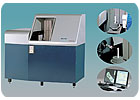
The TomoScope uses X-ray tomography to perform rapid, nondestructive geometrical measurements of interiors and exteriors of complex substrates. Source: Werth Inc.
Reply 50
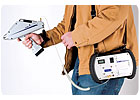
The X

The View X “L” Programmable X-Ray Inspection System is a high-resolution micro-focus X-ray inspection system. Source: Scienscope International
Typical applications include BGA, CSP and flip chip inspection; semiconductor package and wire sweep inspection and solder joint integrity of surface mount; encapsulated components; molded electrical connectors; catheter inspection; inspection of radio opaque markers in stents and implantable medical devices; presents and placement of internal components; and low-density plastic components.
Reply 52
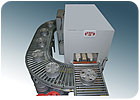
The VJT W4000 X-Ray Wheel Inspection System improves aluminum automotive wheel quality control management. Source: VJ Inspection Systems
Additional features include an industry standard cycle rate (one 17-inch wheel every 30 seconds); multiple views from a single scan; high-resolution imaging system; 250-kilovolt source available with PC-controlled cooler; image and archival system; minimal moving parts for nominal maintenance; ability to scan wheels from 13 inches to 24 inches in diameter; programmable system controller; compliance to US 21CFR1020.40, UVV, DIN54113, VDE-0-100, CE, EUATOM 96/29 and IEC 529.
Reply 53
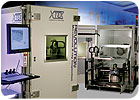
The Revolution NanoTech X-ray inspection system includes a new camera and detector combination, as well as a new validation station for enhanced production capability. Source: X-Tek Group
The validation station option allows viewing and reviewing of captured data off-line, enabling continued use of the X-ray system for production. Data can be accessed remotely by serial number or by barcode scanning.
The system features sub-micron defect detection, 75-degree oblique viewing, digital detectors and automatic BGA software. It offers maximum magnification at all angles over the entire 16-inch by 16-inch manipulator scan area.
Reply 54
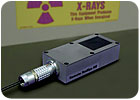
The Remote RadEye HR is a high-resolution detachable X-ray sensitive camera head designed for very small space radiation imaging applications. Source: Rad-icon Imaging Corp.
Historically, the X-ray source determines the resolution of the X-ray system. The X-ray sensor in the Remote RadEye HR was developed to work with microfocus and nanofocus X-ray sources to form compact, high-resolution imaging systems for applications such as micro-CT for industrial and biomedical applications; observing fine structure on small parts; aligning or profiling an X-ray beam for protein crystallography; and evaluating the focal spot size on high-resolution X-ray sources.
The small, detachable sensor module can be placed in constricted areas, and its low mass simplifies cooling of the detector head to reduce dark current and extend the exposure time. The detachable sensor module is housed in a steel enclosure with a stainless steel cover and carbon-fiber window that shields the sensor from ambient light and protects the sensitive electronics.
Reply 55

The 1600 Digital X-Ray Inspection System is comparable in size to a desktop PC and requires no special wiring, external shielding or room modifications for operation. Source: Matsusada Precision Inc.
Standard features include a joystick- and mouse-controlled X-Y stage with a 360-degree rotation fixture, and an image processing CPU with a 17-inch LCD flat panel monitor that controls all system functions. Typical applications include encapsulated components, weld/solder joint integrity, BGA inspection, mechanical and electronics, parts placement, density measurements and general nondestructive imaging.
Reply 56
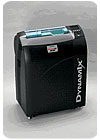
The Dynamix HR has twice the reading density of the previous system and provides true 0.002 by 0.002 pixel resolution, producing 62-megapixel images that enable the detection of even minute defects. Source: FUJIFILM Non-Destructive Testing (NDT) Systems Inc.
Reply 57
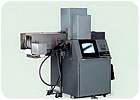
The Accuvue 30-100 portable X-ray inspection machine detects metal, glass, stone, bone and other foreign particles in almost any product. Source: CRX Co. Inc.
Reply 58<
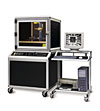
The JewelBox 70T allows manufacturers of medical devices and other products with internal moving parts to observe X-ray images of the devices in motion, to help ensure product quality. Source: Glenbrook Technologies
DVR software streams full-sized (640 by 480) gray-scale images to disk in real time, at up to 30 frames per second on a PC using AVI, a common format for video data. The real-time video may be recorded for playback and analysis. Full-screen color graphics may also be captured and single frames may be annotated for slideshow-style presentations.
The JewelBox 70T incorporates the company’s patented MXRA real-time X-ray microscope camera. The system’s shielded X-ray chamber access ports and proprietary beam-limiting technology ensure safe operating conditions. Its compact size and wheeled base make it easy to move and position in tight quarters.
Reply 59
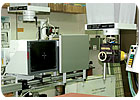
The Flat-foX 17 and foX-Rayzor are lightweight DR systems intended for use both in the laboratory and in the field. Source: Vidisco Ltd.
Reply 60
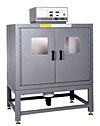
Faxitron X-Ray LLC introduces a line of cabinet X-ray systems for high-resolution X-ray inspection of electronic and industrial parts, components and assemblies. Source: Faxitron X-Ray LLC
Reply 61
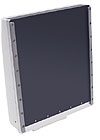
The DXR250 digital radiography system provides high-end functions needed for challenging radiographic inspections. Source: GE Inspection Technologies
The system reduces consumable costs by eliminating the need for film and chemicals. In addition, the reduction in X-ray exposure time results in extended tube life, lower power bills and increased efficiency for the operator.
The solution provides high-end functions needed for challenging radiographic inspections, such as frame averaging for better signal-to-noise ratio and sensitivity and high-pass filtering to accommodate large thickness differentials. Interactive adjustment of gray scale settings provides easy image adjustment without manipulating X-ray settings, allowing the operator to remain focused on the inspection screen at all times.
Reply 62

The Niton XL3 Series is the third generation of Niton handheld XRF analyzers. Source: Thermo Scientific Niton Analyzers
Reply 63
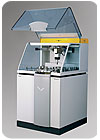
PANalytical’s range of X-ray fluorescence (XRF) spectrometers are enabling industry to meet the new challenges of stringent EU directives. Source: PANalytical
The MiniPal 4 RoHS WEEE analyzer, a benchtop EDXRF spectrometer, is specifically configured to analyze restricted elements in a range of sample types. The Epsilon 5 polarized energy dispersive XRF (EDXRF) spectrometer offers complete quantitative elemental analysis down to sub-ppm levels. The instrument is specifically designed for the analysis of heavy metals and supports the requirements of the directives, for example performing analysis of cadmium and lead in solders.
Axios wavelength dispersive XRF (WDXRF) spectrometers, configured in breakthrough, industry-tailored versions, meet the precise needs of a wide range of RoHS/WEEE applications.
Toxel reference materials, developed in co-operation with DSM Resolve, are helping plastic and polymer manufacturers optimize XRF analysis for toxic heavy metals in polyethylene.
Reply 64

The Edge 3-D scanning system is built on FlashCT technology. Source: Imtec Corp.
Reply 65